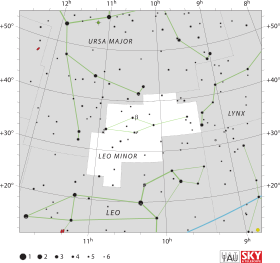Beta Leonis Minoris
| Ascension droite |
10h 27m 52,998s 10h 27m 53,006s |
|---|---|
| Déclinaison |
+36° 42′ 25,95″[1] +36° 42′ 26,01″[2] |
| Constellation | Petit Lion |
| Magnitude apparente |
4,40[3] / 6,12[3] 4,215 (système)[4] |
Localisation dans la constellation : Petit Lion | |
| Type spectral | G8III-IV[3] / F8IV[3] |
|---|---|
| Indice U-B | +0,64[3] |
| Indice B-V | +0,90[3] |
| Indice V-R | 0,5[4] |
| Indice R-I | +0,46[3] |
| Mouvement propre |
μα = −134,15[1] / −102,97[2] mas/a μδ = −113,57[1] / −95,00[2] mas/a |
|---|---|
| Parallaxe | 22,34 ± 0,87 mas[4] |
| Magnitude absolue | 0,96[5] |
| Masse | ~2 M☉[6] / 1,35 M☉ |
|---|---|
| Rayon | 7,8 R☉[6] / 2 R☉ |
| Luminosité | 36 L☉(bolométrique) [6] / 5,8 L☉ |
| Température | 5 075 K[6] / 6 200 K |
| Demi-grand axe (a) | 0,363 ″ |
|---|---|
| Excentricité (e) | 0,668 |
| Période (P) | 38,62 a |
| Inclinaison (i) | 79,1° |
| Argument du périastre (ω) | 29,8° |
| Longitude du nœud ascendant (Ω) | 41,5° |
| Époque du périastre (τ) | B1 999,15 JJ |
Désignations
Beta Leonis Minoris (β Leonis Minoris / β LMi) est une étoile binaire de la constellation du Petit Lion. Elle a une magnitude apparente visuelle globale d'environ 4,215[4]. Bien qu'elle soit la seule étoile du Petit Lion à porter une désignation de Bayer, elle est seulement la deuxième étoile la plus brillante de la constellation (la plus brillante étant 46 Leonis Minoris)[6].
Références
[modifier | modifier le code]- HIP 51233, record for component 1, Hipparcos catalogue; CDS ID I/239.
- HIP 51233, record for component 2, Hipparcos catalogue; CDS ID I/239.
- HR 4100, database entry, The Bright Star Catalogue, 5th Revised Ed. (Preliminary Version), D. Hoffleit and W. H. Warren, Jr., CDS ID V/50. Accessed on line October 1, 2008.
- (en) HD 90537 -- Spectroscopic binary sur la base de données Simbad du Centre de données astronomiques de Strasbourg.
- Système ; à partir de la magnitude apparente et de la parallaxe.
- (en) James B. Kaler, « Beta LMi », sur Stars
- Entry 10279+3642, The Washington Double Star Catalog « https://web.archive.org/web/20080413014054/http://ad.usno.navy.mil/wds/wdsnewframe2.html »(Archive.org • Wikiwix • Archive.is • Google • Que faire ?), , United States Naval Observatory. Accessed on line October 1, 2008.
